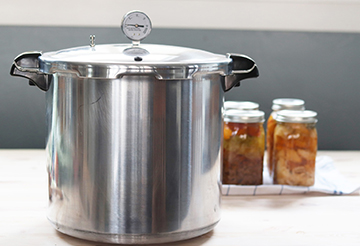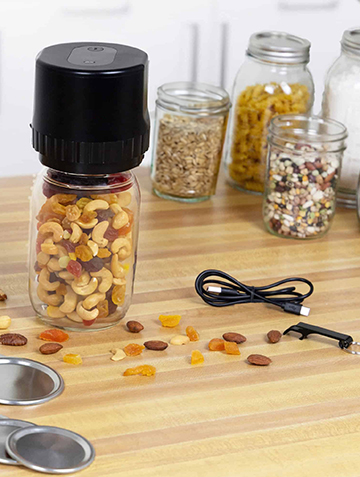
Pressure cooker vs. pressure canner, are they the same?
 Does it matter which one you use to preserve your food? The answer is YES!
Does it matter which one you use to preserve your food? The answer is YES!
A pressure cooker is not designed to preserve food. When food is preserved or ‘canned’ a specific temperature is needed for a certain amount of time to reduce microorganism levels to a safe level. A pressure cooker does not allow the entire thermal process to occur, while a pressure canner does. Therefore, canning in a pressure ‘cooker’ is considered an unsafe method for food preservation.
Some appliances on the market indicate they are able to preserve food as well as cook food. In these cases, it is very important for the user to consult with the manufacturer about the items that can be preserved safely because limited research has been done. We cannot assume that when a product says it can be used for canning that the appropriate research has been done.
Consumers should be cautious if they see claims being made especially for low-acid foods such as vegetables and meats. These items need to be pressure-canned for proper preservation.
Contact your local extension office if you are ever in doubt about an appliance. Learn about pressure canning safely and more at North Central Food Safety Extension Network.
Vacuum sealing mason jars: Are they safe for preservation?
 A new kitchen gadget is gaining popularity on social media: vacuum-sealing mason-style jars. Several brands are available, but the descriptions and images might suggest these tools are a replacement for the research-based canning and heat processing procedures. Mason-style jar vacuum sealers cannot be used to preserve foods that would otherwise be canned and processed using a heat treatment (boiling water bath, atmospheric steam canning, or pressure canning).
A new kitchen gadget is gaining popularity on social media: vacuum-sealing mason-style jars. Several brands are available, but the descriptions and images might suggest these tools are a replacement for the research-based canning and heat processing procedures. Mason-style jar vacuum sealers cannot be used to preserve foods that would otherwise be canned and processed using a heat treatment (boiling water bath, atmospheric steam canning, or pressure canning).
To use, a mason-style jar is filled with food and the standard lid is applied. The vacuum sealer device is aligned on top of the lid, turned on, and oxygen is removed. This creates a vacuum inside the jar which holds the lid in place. This seal may not be air-tight because the plastisol band (sealing compound) on the lid is not heated.
Vacuum sealing can extend the shelf life of certain foods by creating an environment within the jar that has little or no oxygen. Many types of bacteria need oxygen to survive and grow. Depending on the time and temperature conditions, fatty acids in foods can become rancid if they are exposed to oxygen. By removing the air from inside the jar, the shelf life of the food can be improved. However, bacteria such as Clostridium botulinum and Listeria monocytogenes can survive without oxygen and can be a serious food safety risk.
Additionally, filling a jar with steaming hot food and then using the vacuum sealer gadget to seal the jar is not a safe process. When food is properly canned and processed, it reaches an internal temperature of at least 212°F for boiling water bath and atmospheric steam canning, and a temperature between 240 to 250°F with pressure canning. These temperatures play an important role in destroying bacteria and creating a safe environment within the jar.
Vacuum-sealing mason-style jars can be used to safely store and extend the shelf life of certain foods such as dehydrated herbs, spices, grains, legumes, nuts, seeds and dried fruits and vegetables.